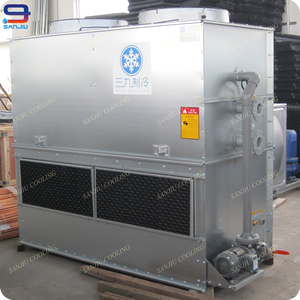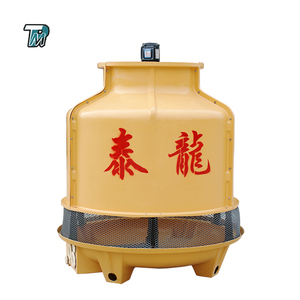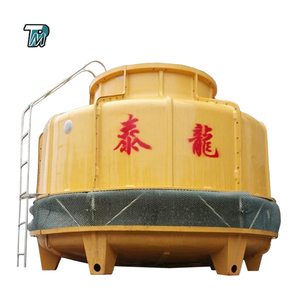(28 products available)















































































































































A 15t chiller is an air conditioning component that uses water or refrigerant to absorb heat from the air, thereby lowering the temperature. Chillers come in two main types: water-cooled and air-cooled. In a water-cooled chiller, the heat from the refrigerant is dissipated through water. This water is usually circulated through the system by a cooling tower. On the other hand, air-cooled chillers use air to expel heat from the refrigerant. A third less common chiller option is the evaporative cooling system, which uses an evaporation process to lower the temperature.
Chiller type:
Based on the working principle, 15T chillers can be classified into air-cooled chillers and water-cooled chillers. Air-cooled chillers use the outside air to dissipate heat. Water-cooled chillers, on the other hand, utilize water as the cooling medium.
Cooling capacity:
The cooling capacity is typically expressed in kilowatts (kW) or tons (1 ton = 3.517 kW), representing the amount of heat the chiller can remove from the cooling medium per unit of time. Note that 15T chiller means its cooling capacity is approximately 15 tons or 52.8 kW.
Coefficient of performance (COP):
The COP reflects the energy efficiency of a 15T chiller, which is the ratio of cooling output to energy input. A higher COP signifies better energy efficiency.
Refrigerant:
The refrigerant is the working fluid used by the chiller to transfer heat. Common refrigerants include R22, R410A, etc. The choice of refrigerant affects the chiller's environmental impact and energy efficiency.
Operating voltage:
15T chillers usually have a three-phase 380V operating voltage, but they can also be customized to other voltages to meet specific application needs.
Regular checks
Regular checks of the chiller's appearance and operation can promptly identify and deal with potential problems. Look for signs like abnormal noise and vibration, refrigerant leakage, etc. Also, check whether the operating parameters are within the specified range, and read the fault information.
Cleaning
With time, the chiller's heat exchanger and fans may accumulate dust and debris, reducing their cooling efficiency. Therefore, they need to be cleaned or vacuumed out.
Also, the interior of air-cooled chillers requires cleaning to remove dust and debris that may have entered during operation.
Replace the coolant
The refrigerant in the chiller should be replaced on schedule based on operating conditions and refrigerant quality. Also, repairs to refrigerant leakage should be made promptly.
Inspect electrical components
Electrical components like contactors, switches, and wires should be checked for loose connections, oxidation, and damage. Necessary cleaning and maintenance should be performed on these components.
This type of chiller does not use ammonia as a refrigerant; therefore, it can be used in refrigeration applications that prefer non-toxic refrigerants. Some examples include food processing facilities, supermarkets, and ice rinks. The 15T air-cooled chiller is also well-suited for commercial settings, such as office buildings, retail spaces, and educational institutions. These buildings can use the chillers to provide centralized cooling for open-plan offices, meeting rooms, and computer labs. Moreover, 15T water-cooled chillers offer flexibility for large-scale industrial operations, such as petrochemical plants, pharmaceuticals, and water treatment facilities. These industries can use the machines to maintain optimal temperatures for production processes, equipment cooling, and product preservation.
Because of their efficiency and eco-friendliness, large-scale 15T chillers suit facilities with high cooling demands, such as data centers, hospitals, and hotels. Data centers can use them to ensure that server rooms stay cool. High-performance 15T precision chillers with robust controls are suitable for high-performance applications like laboratories, clean rooms, and electronic manufacturing. These fields can use them to provide precise and stable temperature control.
When selecting a chiller for a specific application, some factors should be considered.
Load analysis
Perform a load analysis to determine the cooling load the chiller will be required to handle. Consider factors such as peak and average cooling demands, temperature and humidity requirements, and any fluctuations in the cooling load over time. This analysis will help identify the appropriate chiller size.
Operating efficiency
Consider the chiller's energy efficiency. Look at the chiller's coefficient of performance (COP) or energy efficiency ratio (EER) to select one with a high level of efficiency to minimize operating costs and environmental impact.
Refrigerant options
Consider the environmental impact of the refrigerant used by the chiller. Some refrigerants have higher global warming potentials than others. Consider using chillers with eco-friendly refrigerants or those complying with environmentally acceptable regulations.
Noise levels
Consider the noise level produced by the chiller, especially if it will be located near occupied spaces or residential areas. Choose a chiller designed to operate at lower noise levels or consider using sound enclosures and attenuation measures if necessary.
System compatibility
Determine the chiller's compatibility with the existing HVAC system. Consider factors such as the chiller's cooling method (air or water-cooled), the condenser used, and the distribution system to ensure proper integration and performance.
Budget and lifecycle costs
Determine the a budget designated for purchasing the chiller. Also, consider lifecycle factors such as maintenance and operating costs and potential energy savings to make a cost-effective investment.
Q1: What does a chiller do in HVAC?
A1: An HVAC chiller's primary function is to eliminate heat. Chillers are fantastic heat pumps that remove heat from a building and then transfer it, typically to the outside air. Chillers come in a variety of sizes and are often used in larger commercial or industrial buildings.
Q2: What is the difference between air-cooled and water-cooled chillers?
A2: Air-cooled chillers discharge heat to the atmosphere using cool air that is circulated through the condenser coils by fans. Water-cooled chillers utilize water to absorb heat from the condenser coils and then send it back to cooling towers that release the heat.
Q3: What are the two types of chillers frequently used in industries?
A3: The absorption chiller and the vapor compression chiller are the two types of chillers that are usually used. The absorption chillers make use of heat to make cooling happen, while the vapor compression chillers utilize electricity.